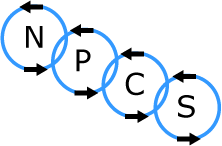Nutrient Cycling
Soil stores, moderates the release of, and cycles nutrients and other elements. During these biogeochemical processes, analogous to the water cycle, nutrients can be transformed into plant available forms, held in the soil, or even lost to air or water.
 Nutrient cycling can be assessed by measuring the following indicators:
Nutrient cycling can be assessed by measuring the following indicators:
Fertility Indicators including mineral nitrogen, potentially mineralizable nitrogen, soil nitrate, soil test phosphorus, potassium, sulfur, calcium, magnesium, boron, and zinc
Organic Matter Indicators including C:N ratio, decomposition, microbial biomass carbon, particulate organic matter, soil enzymes, soil organic matter, total organic carbon and total organic matter
Soil Reaction Indicators including soil pH
Soil is the major "switching yard" for the global cycles of carbon, water, and nutrients. Carbon, nitrogen, phosphorus, and many other nutrients are stored, transformed, and cycled through soil.
Decomposition by soil organisms is at the center of the transformation and cycling of nutrients through the environment. Decomposition liberates carbon and nutrients from the complex material making up life forms-putting them back into biological circulation so they are available to plants and other organisms. Decomposition also degrades compounds in soil that would be pollutants if they entered ground or surface water.
Decomposition is a stepwise process involving virtually all soil organisms. Arthropods and earthworms chew the material and mix it with soil. A few fungi may break apart one complex compound into simpler components, then bacteria can attack the newly created compounds, and so on. Each organism gets energy or nutrients from the process. Usually, but not always, compounds become simpler after each step. The portion of plant and animal residue that is not broken down plays a crucial role in soil. It is transformed into the highly complex organic compounds called humic substances that can persist in soil for centuries and are important to soil structure and nutrient storage.
Carbon Dioxide and Soil
The carbon cycle illustrates the role of soil in cycling nutrients through the environment. More carbon is stored in soil than in the atmosphere and above-ground biomass combined. Soil carbon is in the form of organic compounds originally created through photosynthesis in which plants convert atmospheric carbon dioxide (CO2) into plant matter made of organic carbon compounds, such as carbohydrates, proteins, oils, and fibers. The organic compounds enter the soil system when plants and animals die and leave their residue in or on the soil. Immediately, soil organisms begin consuming the organic matter, extracting energy and nutrients and releasing water, heat, and CO2 back to the atmosphere. Thus, if no new plant residue is added to the soil, soil organic matter will gradually disappear. If plant residue is added to the soil at a faster rate than soil organisms convert it to CO2, carbon will gradually be removed from the atmosphere and stored (sequestered) in the soil. Cultivation aerates the soil, triggering increased biological activity, and therefore rapid decomposition, loss of soil organic matter, and release of CO2 into the atmosphere. Most soil carbon losses occur in the first several years after cultivation begins, as took place in many U.S. soils in the 1800's. Farmers and other conservationists are interested in reversing that effect and increasing the amount of carbon stored in the soil. In general, reducing tillage can increase the extent of carbon sequestration and the amount of organic matter retained in the soil.
